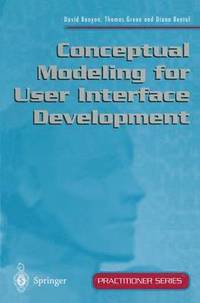
- Format
- Häftad (Paperback / softback)
- Språk
- Engelska
- Antal sidor
- 187
- Utgivningsdatum
- 1999-06-01
- Upplaga
- Softcover reprint of the original 1st ed. 1999
- Förlag
- Springer London Ltd
- Medarbetare
- etc.
- Illustrationer
- 13 Illustrations, black and white; XIII, 187 p. 13 illus.
- Dimensioner
- 235 x 156 x 14 mm
- Vikt
- Antal komponenter
- 1
- Komponenter
- 1 Paperback / softback
- ISBN
- 9781852330095
- 291 g
Conceptual Modeling for User Interface Development
- Skickas från oss inom 7-10 vardagar.
- Fri frakt över 249 kr för privatkunder i Sverige.
Passar bra ihop
De som köpt den här boken har ofta också köpt Co-Intelligence av Ethan Mollick (häftad).
Köp båda 2 för 950 krKundrecensioner
Fler böcker av författarna
-
Designing User Experience
David Benyon
-
Designing with Blends
Manuel Imaz, David Benyon
-
Domain Knowledge for Interactive System Design
Alistair G Sutcliffe, Frans Van Assche, David Benyon
-
Domain Modelling for Interactive Systems Design
Alistair G Sutcliffe, David Benyon
Innehållsförteckning
1. Modeling in User Interface Development.- 1.1 User Interface Development.- 1.2 Principles of Design.- 1.3 Models in Design.- 1.4 User Interface Development: The Functional View.- 1.5 Models of Dynamics.- 1.6 Models of Structure.- 1.7 The Role of ERMIA in User Interface Development.- 2. An Introduction to ERMIA.- 2.1 Evaluating Designs and Devices.- 2.2 ERMIA in a Nutshell.- 2.3 Information Artefacts.- 2.4 The Uses of ERMIA.- 3. The Components of an ERMIA Model.- 3.1 The Components.- 3.2 Entity.- 3.3 Relationship.- 3.4 Attribute.- 3.5 Entity, Relationship or Attribute?.- 3.6 Example: A Database of Papers Submitted to a Conference.- 3.7 Example: Telephone Network.- 4. Conceptual and Perceptual ERMIAs.- 4.1 The Information to Be Displayed versus the Display Itself.- 4.2 Manifest and Conceptual Entities and Relationships.- 4.3 Perceptually-coded Attributes.- 4.4 Example: A List Viewport.- 4.5 Distributed Conceptual Information.- 4.6 Comparing Different User Views.- 5. Searching for Information.- 5.1 Information Can Be Hard to Find.- 5.2 The Five Types of Entity Store.- 5.3 Example: The List of Flowers Revisited.- 5.4 Searching More Complex Structures.- 6. Dealing with Complex Relationships.- 6.1 Decomposing Many-to-Many Relationships.- 6.2 Different Manifest Structures Lead to Different Search.- 6.3 Making Many-to-Many Relationships Easy to Explore.- 6.4 Example: A Drum Machine Pattern Sequencer.- 6.5 Fossil Silt.- 7. Standard Structures and Safe Paths.- 7.1 Standard Structures for Search.- 7.2 Safe Trails.- 7.3 Connection Traps.- 7.4 Short Cut Keys.- 8. Representing Different Views.- 8.1 Levels of Information Artefacts.- 8.2 Example: Currency Exchange.- 8.3 Different Views Facilitate Different Tasks.- 8.4 Representing Mental Models.- 9. Developing ERMIAs.- 9.1 ERMIA as aLanguage for Design.- 9.2 Heuristics for ERMIA.- 9.3 Methodology for ERMIA.- 9.4 Case Study: The Oven Hob Problem.- 9.5 Building the ERMIA.- 10. Practical ERMIA Modeling.- 10.1 The Appointments Diary.- 10.2 The Alarm Clock.- 10.3 The ATM.- 11. Case Study.- 11.1 The Domain.- 11.2 Conceptual ERMIA of XBarnacle.- 11.3 A Perceptual ERMIA of the XBarnacle Interface.- 11.4 Using ERMIA to Identify Potential Usability Problems.- 11.5 Did the problems materialize?.- 11.6 Introducing critics: XBarnacle.- 12. Conclusions.- 12.1 ERMIA and Other Techniques.- 12.2 Choosing a Modeling Method.- 12.3 Usability Issues.- 12.4 Future Developments.- Solutions to Exercises.- Summary of Notation.- Resources.


